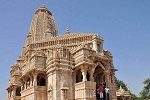
Meerabai
After the 10 th century, well-established traditions of knowledge and spirituality in India faced a sudden rupture. Invaders from middle Asia breached the boundaries of this country with a zeal for religious conversion. They were bent upon ruining everything that was not compatible with their rigid minds. There was no place for discussion or give and take. Shastrarth was replaced by the tip of sword. Obviously in such conditions, ‘tark’ and ‘mimansa’ had very little use. Political power and military might had failed in their task to defend. Centers of knowledge were decimated by brutal force. In such brutal conditions, throughout history, there has hardly been a society that could protect its identity and soul. But here in India appeared a long chain of saint-poets as saviors of the essence of Sanatan. These saints reconstructed the ancient knowledge propagated in scriptures into people’s language and often as poetry dedicated to their deity worshipped as manifestation of formless absolute. One such saint poet was the great devotee of Krishna- Meera Bai.
Early life and devotion to Krishna
Meera was born (1498 on Sharad Purnima) in a well-established family of royal descent in Rajputana or Rajasthan province of western India. She was the only offspring of Ratan Singh- the younger brother of king of Medta. From very early childhood devotion to Krishna was imbedded in her heart. Her mother died very early and her grandfather took care of her. He himself was the ardent devotee of Krishna. Once a saint visited her home. He gave a small idol of Krishna to her. Meera addressed it as Gopal ji and since then, that idol became her constant companion. Meera and her devotion took the form of an unhindered stream.
Marriage
Meera was married to Prince Bhoj of the powerful Sisodia dynasty of Chittor. Glory of Chittor was at its apex at that time and Meera was supposed to fit in the role of a maharani (queen). But Meera’s devotion to her Gopal ji was unconditional and above all. Naturally that resulted in a family conflict and reached to the extent that Meera decided to leave home to reside in Vrindavan- the place of her Gopal ji. She asked renowned saint Goswami Tulsidas about this and there came his famous answer- ‘those should be abandoned as enemies, in whose heart do not dwell Ram and Vaidehi’. In Virndavan she was welcomed by saints and devotees. Meera accepted Saint Ravidas as her guru.
The incident of her death shows the heights of devotion she was dwelling at. A true devotee is constantly oriented to Isht, when the devotion is more condensed and devotee feels constant nearness, then comes attachment and similarity of form. But the ultimate end of devotion is to assimilate into- to be one with. It is said that Meera, while chanting the devotional songs reached near the idol of Ranchhor ji in Dwarika and disappeared. Nobody could find out where she was gone.
Poetry
Poetry composed by Meera in devotion to Krishna is found in form of 4 books- Narsi ka Mayra, Geet Govind Teeka, Rag Govind, Rag Sorath ke Pad. Her compositions are famous throughout India. Her bhajans, which usually end with the phrase ‘Meera ke prabhu Giridhar Nagar’, are a staple in most houses in Northern India.
Temples
There are several temples associated with various stages in Meerabai’s life. The Chaturbhuja temple in Merta is where Meera worshipped Krishna before she was married. The Kumbh Shyam temple in Chittorgarh was built by her father-in-law so she could continue her devotional services. Meerabai temple in Vrindavan is where she stayed when she left Chittor for some time. Her Shaligram is still worshipped. The Jagat Shiromani Temple in Amer and BrijRaj Bihari temple in Himachal Pradesh are said to house Krishna idols worshipped by Meerabai.
(Author Baba Pagaldas is an initiate disciple of Mahatma Baikal Das)




